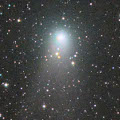
|
Now it is 8.1 mag (July 27, Juan Jose Gonzalez). It keeps so bright as 6-8 mag for a long time from 2011 to 2012, and will be observable in good condition in the Northern Hemisphere. In the Southern Hemisphere, it keeps observable in good condition until October when it brightens up to 6.5 mag.
Date(TT) R.A. (2000) Decl. Delta r Elong. m1 Best Time(A, h)
July 30 21 43.14 11 35.7 1.570 2.474 145 7.8 1:16 (180, 43)
Aug. 6 21 19.17 13 53.6 1.481 2.408 148 7.6 0:25 (180, 41)
|
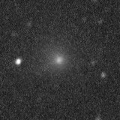
|
It has returned after 27-year blank since 1984. It brightened very rapidly, and became very bright as 9.1 mag (July 10, Tsutomu Seki). However, it is not observable now. It will never be observable again in this apparition.
Date(TT) R.A. (2000) Decl. Delta r Elong. m1 Best Time(A, h)
July 30 7 4.74 21 13.3 1.602 0.753 21 10.6 5:29 (245, -2)
Aug. 6 7 42.46 16 39.4 1.631 0.749 19 10.6 5:24 (251, -2)
|
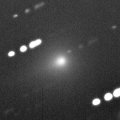
|
It will approach to the sun down to 0.5 A.U. in September, and it is expected to brighten up to 6 mag. Now it is 9.5 mag, brightening rapidly (July 30, Michael Mattiazzo). In the Southern Hemisphere, it keeps observable until early September when it becomes 7 mag. In the Northern Hemisphere, it is not observable for a while. But after appearing in the morning sky in October, it becomes observable in the excellent condition at midnight.
Date(TT) R.A. (2000) Decl. Delta r Elong. m1 Best Time(A, h)
July 30 11 22.25 2 46.4 1.537 1.070 43 11.2 18:43 (112, 24)
Aug. 6 11 35.26 1 24.4 1.447 0.947 40 10.6 18:47 (108, 22)
|
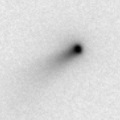
|
Now it is very bright as 11.3 mag (July 28, Juan Jose Gonzalez). It will approach to the earth down to 0.06 A.U. and brighten up to 7-8 mag in mid August. In the Northern Hemisphere, it is observable until early August when it brightens up to 10 mag. Then it goes away to the southern sky and becomes unobservable temporarily But it appears in the morning sky again at 7 mag in mid September, then it keeps observable while fading gradually. In the Southern Hemisphere, it is observable until mid August when it brightens up to 8 mag. But after that, it is not observable until winter when it becomes fainter than 16 mag.
Date(TT) R.A. (2000) Decl. Delta r Elong. m1 Best Time(A, h)
July 30 21 59.90 -27 23.8 0.244 1.246 158 13.3 1:32 (180, 82)
Aug. 6 22 16.97 -36 53.4 0.146 1.148 154 11.4 1:20 ( 0, 89)
|
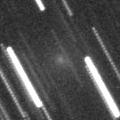
|
It will approach to the sun down to 0.9 A.U. in early September. It will keep 12 mag in summer and autumn. Now it is 12.8 mag and visible visually (July 6, Jakub Cerny). But it is diffuse, and the central part is extremely faint as 18 mag. In the Northern Hemisphere, it keeps observable until winter, although it becomes very low from mid August to late September. In the Southern Hemisphere, it is not observable until November.
Date(TT) R.A. (2000) Decl. Delta r Elong. m1 Best Time(A, h)
July 30 6 0.38 73 9.2 1.268 1.139 58 12.6 5:29 (196,-26)
Aug. 6 8 1.69 69 46.4 1.288 1.068 53 12.5 5:24 (204,-31)
|
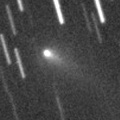
|
Now it is bright as 10.4 mag (July 27, Juan Jose Gonzalez). It will brighten up to 10-11 mag in autumn. In the Northern Hemisphere, it keeps observable for a long time until 2012 spring, although it becomes low temporarily in July. In the Southern Hemisphere, it is not observable until November.
Date(TT) R.A. (2000) Decl. Delta r Elong. m1 Best Time(A, h)
July 30 7 50.35 61 51.2 2.629 2.023 43 13.0 5:29 (213,-30)
Aug. 6 7 53.85 60 16.8 2.591 2.008 45 12.9 5:24 (214,-27)
|

|
It will be 12-13 mag in June and July. However, it is not observable at all due to the bad condition in this apparition.
Date(TT) R.A. (2000) Decl. Delta r Elong. m1 Best Time(A, h)
July 30 9 18.26 20 27.5 2.410 1.423 10 13.0 18:43 (108,-10)
Aug. 6 9 41.85 18 55.9 2.433 1.443 9 13.2 18:47 (105,-11)
|
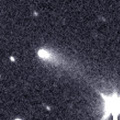
|
First return of a new periodic comet which brightened up to 13 mag in a major outburst in 2005. Now it is very bright as 12.0 mag and visible visually (July 28, Juan Jose Gonzalez). It will be observable in an excellent condition from summer to winter.
Date(TT) R.A. (2000) Decl. Delta r Elong. m1 Best Time(A, h)
July 30 23 20.49 1 50.4 1.309 2.146 134 13.0 2:52 (180, 53)
Aug. 6 23 18.80 2 39.8 1.269 2.154 141 13.0 2:23 (180, 52)
|
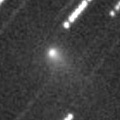
|
Very bright and visible visually as 12.8 mag (July 27, Jakub Cerny). It will be observable at 13 mag in good condition in summer. In the Northern Hemisphere, it keeps observable at 14-15 mag in good condition until autumn. In the Southern Hemisphere, it will become low after August.
Date(TT) R.A. (2000) Decl. Delta r Elong. m1 Best Time(A, h)
July 30 20 11.14 23 42.4 1.057 1.929 137 13.5 23:37 (180, 31)
Aug. 6 19 38.29 27 48.7 1.101 1.925 130 13.6 22:37 (180, 27)
|
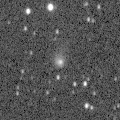
|
Now it is bright and visible visually at 13.1 mag (June 6, Chris Wyatt). It keeps bright as 13-14 mag for a long time after this until 2013. It is not observable in the Northern Hemisphere, but it is observable in good condition in the Southern Hemisphere.
Date(TT) R.A. (2000) Decl. Delta r Elong. m1 Best Time(A, h)
July 30 10 56.89 -75 7.2 5.367 5.573 96 13.5 18:43 ( 18, 40)
Aug. 6 11 0.96 -74 46.5 5.406 5.562 93 13.5 18:47 ( 18, 39)
|
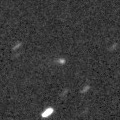
|
Now it is 15.2 mag (June 24, Hidetaka Sato). It brightens up to 12 mag in autumn. But the condition is bad. In the Northern Hemisphere, it is already extremely low, and it will be unobservable in August. After the perihelion passage, it is only observable from December to February in the evening very low sky. In the Southern Hemisphere, it keeps observable for a long time, although it keeps locating extremely low. The component B was not detected, fainter than 20 mag (May 14, Hidetaka Sato).
Date(TT) R.A. (2000) Decl. Delta r Elong. m1 Best Time(A, h)
July 30 11 7.81 12 59.7 2.111 1.439 37 13.9 18:43 (118, 15)
Aug. 6 11 24.33 10 44.4 2.075 1.374 35 13.7 18:47 (113, 14)
|
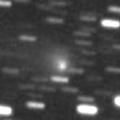
|
Now it is 13.2 mag and visible visually (July 5, Jakub Koukal). It will be observable at 13-14 mag for a long time from 2011 to 2012.
Date(TT) R.A. (2000) Decl. Delta r Elong. m1 Best Time(A, h)
July 30 18 51.81 -7 3.4 4.579 5.499 152 13.9 22:20 (180, 62)
Aug. 6 18 43.09 -7 30.9 4.620 5.480 144 13.9 21:44 (180, 63)
|
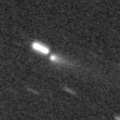
|
Already bright and visible visually at 14.5 mag (July 28, Jakub Cerny). It will be observable in good condition at 12 mag in autumn and winter.
Date(TT) R.A. (2000) Decl. Delta r Elong. m1 Best Time(A, h)
July 30 23 58.71 7 9.3 1.693 2.407 123 14.5 3:30 (180, 48)
Aug. 6 0 0.96 7 28.8 1.601 2.379 129 14.2 3:05 (180, 47)
|

|
Now it is bright as 12.5 mag and visible visually (June 23, Chris Wyatt). It is getting lower in the evening sky. It has been already too low to observe in the Northern Hemisphere. It will be unobservable in mid August in the Southern Hemisphere.
Date(TT) R.A. (2000) Decl. Delta r Elong. m1 Best Time(A, h)
July 30 11 9.10 -0 43.5 6.970 6.259 42 14.2 18:43 (107, 24)
Aug. 6 11 13.29 -1 9.5 7.039 6.260 37 14.2 18:47 (102, 19)
|

|
Big asteroid discovered in 1906. It suddenly showed the cometary activity on Dec. 11, probably due to an impact of a small object. It was very bright as 11.5 mag visually (Dec. 17, Juan Jose Gonzalez). It had a dust coma still on Jan. 9 (Joseph Brimacombe). Now it is stellar at 13.8 mag (Apr. 5, Juan Jose Gonzalez). It is getting lower in the evening sky, and will be unobservable in August.
Date(TT) R.A. (2000) Decl. Delta r Elong. m1 Best Time(A, h)
July 30 11 1.13 18 25.4 3.510 2.735 34 14.5 18:43 (121, 10)
Aug. 6 11 11.63 17 7.1 3.544 2.724 30 14.5 18:47 (116, 7)
|
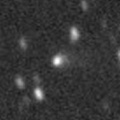
|
It brightened rapidly and reached up to 14.9 mag now (July 23, C. Rinner, F. Kugel). It will be observable at 15 mag in good condition from July to October. It locates somewhat low in the Northern Hemisphere.
Date(TT) R.A. (2000) Decl. Delta r Elong. m1 Best Time(A, h)
July 30 20 28.39 -22 28.4 1.326 2.339 175 15.1 0:01 (180, 77)
Aug. 6 20 23.97 -23 39.1 1.328 2.331 168 15.0 23:25 (180, 79)
|
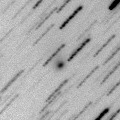
|
Now it is fading slowly, but still bright and visible visually as 13.8 mag (July 12, Jakub Cerny). It will keep 14-15 mag until mid September.
Date(TT) R.A. (2000) Decl. Delta r Elong. m1 Best Time(A, h)
July 30 23 38.62 -4 9.6 2.391 3.171 132 15.1 3:11 (180, 59)
Aug. 6 23 31.00 -7 11.6 2.350 3.214 142 15.2 2:36 (180, 62)
|
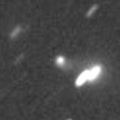
|
Now it is 14.8 mag and visible visually (July 5, Jakub Cerny). It keeps 15 mag from 2011 summer to 2012 summer. But it is not observable around the perihelion. It is observable in good condition in the Northern Hemisphere in 2011, and in the Southern Hemisphere in 2012.
Date(TT) R.A. (2000) Decl. Delta r Elong. m1 Best Time(A, h)
July 30 13 39.12 16 18.0 2.945 2.803 71 15.3 18:43 (152, 34)
Aug. 6 13 46.75 14 44.8 2.975 2.762 68 15.3 18:47 (145, 33)
|

|
It is expected to keep 14-15 mag for a long time from 2011 summer to 2012 summer. The condition is good in the Southern Hemisphere, and it keeps observable for a long time. In the Northern Hemisphere, it is not observable until 2012 August. However, this comet was observed only during two days in 2010 June. So the orbital elements are extremely uncertain.
Date(TT) R.A. (2000) Decl. Delta r Elong. m1 Best Time(A, h)
July 30 16 8.31 -50 28.5 2.507 3.128 119 15.4 19:37 ( 0, 74)
Aug. 6 15 58.21 -50 56.4 2.555 3.079 111 15.4 19:00 ( 0, 74)
|
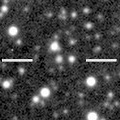
|
Brightening rapidly. Now it is 15.0 mag (July 18, Hidetaka Sato). It was observed as bright as 14.0 mag visually (June 27, Jakub Koukal). It is expected to be 13 mag and will be observable in good condition in 2013. In the Northern Hemisphere, it keeps observable for a long time after this. It is not observable in the Southern Hemisphere.
Date(TT) R.A. (2000) Decl. Delta r Elong. m1 Best Time(A, h)
July 30 1 59.48 62 12.4 7.618 7.465 77 15.5 5:29 (180, -7)
Aug. 6 1 55.03 62 56.5 7.504 7.437 82 15.4 4:59 (180, -8)
|

|
It has brightened in outburst up to 14 mag in 2006 January. Another outburst occured in late May, and brightened up to 14.3 mag (June 4, Juan Jose Gonzalez). It is still bright as 14.5 mag (June 27, Jakub Koukal). It will be getting lower in the evening sky after this, and will be unobservable in October.
Date(TT) R.A. (2000) Decl. Delta r Elong. m1 Best Time(A, h)
July 30 16 1.97 -16 8.5 7.875 8.358 115 15.5 19:31 (180, 71)
Aug. 6 16 1.81 -16 11.2 7.961 8.339 108 15.6 19:04 (180, 71)
|
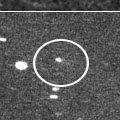
|
Now it is 14.7 mag (July 27, Rolando Ligustri). Brighter than originally predicted. It will be observable at 15-16 mag in good condition from summer to autumn.
Date(TT) R.A. (2000) Decl. Delta r Elong. m1 Best Time(A, h)
July 30 23 21.72 -15 42.5 1.233 2.115 140 15.6 2:54 (180, 71)
Aug. 6 23 21.75 -16 24.0 1.201 2.122 146 15.6 2:26 (180, 71)
|

|
Now it is 17.1 mag (June 24, J. F. Hernandez). It will brighten up to 13 mag in next winter. But the condition of this apparition is bad, and it will not be observable around the perihelion passage. It will be unobservable soon in the Northern Hemisphere. It will be observable until September when it brightens up to 15 mag in the Southern Hemisphere.
Date(TT) R.A. (2000) Decl. Delta r Elong. m1 Best Time(A, h)
July 30 11 50.81 6 31.7 2.536 2.023 49 16.0 18:43 (121, 27)
Aug. 6 12 2.86 4 48.3 2.554 1.986 45 15.9 18:47 (115, 25)
|
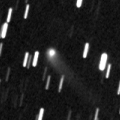
|
Now it is 15.9 mag (June 27, P. Dupouy). It will be fading very slowly after this. In the Northern Hemisphere, it keeps observable for a long time until 2012 spring when it fades down to 17-18 mag. It will not be observable in the Southern Hemisphere.
Date(TT) R.A. (2000) Decl. Delta r Elong. m1 Best Time(A, h)
July 30 22 54.89 53 1.6 4.815 5.126 102 16.0 2:27 (180, 2)
Aug. 6 22 52.65 53 9.6 4.780 5.152 106 16.0 1:57 (180, 2)
|
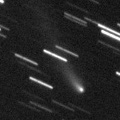
|
It reached up to 14 mag in 2010 autumn and winter. Now it is fading. In the Southern Hemisphere, it keeps observable in good condition while fading gradually. In the Northern Hemisphere, it will never be observable again.
Date(TT) R.A. (2000) Decl. Delta r Elong. m1 Best Time(A, h)
July 30 6 3.02 -37 24.0 3.677 3.403 66 16.0 5:29 (292, 41)
Aug. 6 6 8.87 -39 49.5 3.657 3.437 69 16.0 5:24 (294, 45)
|
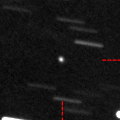
|
It is expected to be bright as 9 mag from 2012 to 2013. Now it is 16.7 mag (June 19, Toshiyuki Takahashi). In the Northern Hemisphere, although it becomes low temporarily in 2011 autumn, it keeps observable in good condition for a long time until 2012 autumn when the comet brightens up to 10 mag. In the Southern Hemisphere, it is hardly observble before the perihelion passage. But it becomes observable in good condition since 2013 after the perihelion passage.
Date(TT) R.A. (2000) Decl. Delta r Elong. m1 Best Time(A, h)
July 30 11 59.70 55 1.3 6.457 5.901 52 16.3 18:43 (154, -9)
Aug. 6 12 5.77 54 4.0 6.423 5.842 51 16.2 18:47 (151,-11)
|
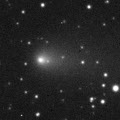
|
It became bright as 12 mag in 2010. Now it is fading. It has already faded down to 17.2 mag (July 5, Hidetaka Sato).
Date(TT) R.A. (2000) Decl. Delta r Elong. m1 Best Time(A, h)
July 30 2 15.81 4 28.5 3.449 3.647 93 16.2 5:29 (187, 50)
Aug. 6 2 18.35 4 32.7 3.368 3.667 99 16.2 5:22 (180, 50)
|
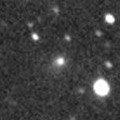
|
Now it is 16.0 mag (July 6, C. Rinner, F. Kugel). It will brighten up to 16 mag from summer to autumn, and will be observable in good condition.
Date(TT) R.A. (2000) Decl. Delta r Elong. m1 Best Time(A, h)
July 30 16 15.27 -4 6.3 1.481 2.121 115 16.2 19:45 (180, 59)
Aug. 6 16 20.18 -5 2.7 1.528 2.105 110 16.3 19:22 (180, 60)
|
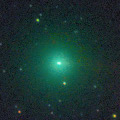
|
It approached to the sun down to 0.88 A.U. in mid April, and it brightened up to 8.6 mag (Apr. 13, Juan Jose Gonzalez). Now it is fading. It has already faded down to 16.1 mag by CCD observations (July 29, Hidetaka Sato). However, it is still very bright visually as 11.5 mag (July 12, Jakub Cerny). It will get diffuse and fade out rapidly after this.
Date(TT) R.A. (2000) Decl. Delta r Elong. m1 Best Time(A, h)
July 30 2 42.92 16 5.3 1.756 1.919 83 16.3 5:29 (194, 38)
Aug. 6 2 47.50 15 37.3 1.755 2.009 88 16.7 5:24 (189, 39)
|
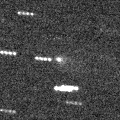
|
Now it is 15.5 mag (July 1, Hidetaka Sato). It will be fading gradually, and will be fainter than 18 mag in September.
Date(TT) R.A. (2000) Decl. Delta r Elong. m1 Best Time(A, h)
July 30 0 32.11 -13 4.7 1.641 2.353 122 16.4 4:04 (180, 68)
Aug. 6 0 30.92 -13 45.2 1.615 2.394 129 16.5 3:35 (180, 69)
|

|
Now it is 16.6 mag (July 22, Hidetaka Sato). In the Southern Hemisphere, it keeps observable at 16-17 mag for a long time from summer to winter. It is not observable in the Northern Hemisphere.
Date(TT) R.A. (2000) Decl. Delta r Elong. m1 Best Time(A, h)
July 30 21 53.00 -70 57.5 1.501 2.258 126 16.4 1:27 ( 0, 54)
Aug. 6 21 1.77 -76 35.6 1.524 2.216 120 16.4 0:11 ( 0, 49)
|

|
Appearing in the morning sky. Now it is 17.2 mag (July 18, Hidetaka Sato). It will brighten rapidly, and will be obserbale at 14 mag in good condition in autumn. It locates somewhat low in the Southern Hemisphere.
Date(TT) R.A. (2000) Decl. Delta r Elong. m1 Best Time(A, h)
July 30 4 45.98 6 33.6 1.997 1.675 56 16.8 5:29 (232, 33)
Aug. 6 5 6.48 7 8.5 1.927 1.638 58 16.6 5:24 (231, 32)
|
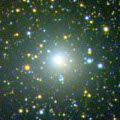
|
It reached up to 7.7 mag in 2009 summer (2009 Aug. 13, Chris Wyatt). Now it is fading. It has already faded down to 15.3 mag (June 29, Hidetaka Sato). It will never be observable again in the Northern Hemisphere. In the Southern Hemisphere, it keeps observable in good condition until 2011 autumn when it becomes fainter than 18 mag.
Date(TT) R.A. (2000) Decl. Delta r Elong. m1 Best Time(A, h)
July 30 15 29.23 -62 19.6 6.810 7.263 112 16.7 18:59 ( 0, 63)
Aug. 6 15 24.88 -61 42.7 6.941 7.311 107 16.8 18:47 ( 5, 63)
|
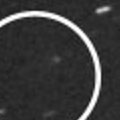
|
Now it is 17.4 mag (June 24, J. F. Hernandez). It will brighten up to 15 mag in autumn and winter. But the condition of this apparition is bad. It is not observable around the perihelion passage. It will be getting lower in the evening sky after this. In the Southern Hemisphere, it will be observable until September when it brightens up to 16 mag. In the Northern Hemisphere, it will be unobservable soon.
Date(TT) R.A. (2000) Decl. Delta r Elong. m1 Best Time(A, h)
July 30 12 19.25 -10 37.0 2.292 2.035 62 17.0 18:43 (111, 44)
Aug. 6 12 31.22 -11 41.5 2.318 1.996 59 16.8 18:47 (106, 40)
|
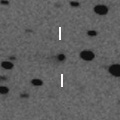
|
Now it is 17.3 mag (June 26, Hidetaka Sato). It keeps observable at 17 mag for a long time from 2011 to 2012.
Date(TT) R.A. (2000) Decl. Delta r Elong. m1 Best Time(A, h)
July 30 0 55.17 19 12.8 7.688 8.024 105 17.0 4:27 (180, 36)
Aug. 6 0 51.79 19 11.0 7.575 8.026 113 16.9 3:56 (180, 36)
|
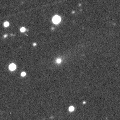
|
Now it is 16.5 mag (July 2, J. F. Hernandez). It was observed around 16 mag in 2009 and 2010. In 2011, it keeps observable at 17 mag from spring to autumn. It locates somewhat low in the Northern Hemisphere.
Date(TT) R.A. (2000) Decl. Delta r Elong. m1 Best Time(A, h)
July 30 16 52.36 -23 42.7 3.499 4.203 128 17.2 20:21 (180, 79)
Aug. 6 16 51.69 -23 46.3 3.594 4.212 121 17.3 19:53 (180, 79)
|

|
New comet. In the Southern Hemisphere, it is observable at 18 mag in good condition in July. In the Northern Hemisphere, it locates extremely low.
Date(TT) R.A. (2000) Decl. Delta r Elong. m1 Best Time(A, h)
July 30 14 30.31 -34 7.5 2.347 2.705 99 17.7 18:43 ( 93, 81)
Aug. 6 14 40.04 -32 53.5 2.403 2.682 94 17.7 18:47 ( 94, 76)
|

|
New comet discovered by de la Cueva, et al., Spain. It keeps 17-18 mag until early 2013. It keeps observable in good condition until early 2012 in the Southern Hemisphere, although it locates low in the Northern Hemisphere. In the Northern Hemisphere, it will be observable in good condition from 2012 autumn to early 2013.
Date(TT) R.A. (2000) Decl. Delta r Elong. m1 Best Time(A, h)
July 30 1 15.03 -40 20.4 3.033 3.610 117 18.0 4:47 ( 0, 85)
Aug. 6 1 17.45 -41 18.4 2.957 3.581 120 17.9 4:21 ( 0, 84)
|
|
![]()
 213P/2009 B3 ( Van Ness )
213P/2009 B3 ( Van Ness ) C/2011 L3 ( McNaught )
C/2011 L3 ( McNaught ) C/2009 F4 ( McNaught )
C/2009 F4 ( McNaught ) 73P/Schwassmann-Wachmann 3
73P/Schwassmann-Wachmann 3 C/2006 S3 ( LONEOS )
C/2006 S3 ( LONEOS ) 78P/Gehrels 2
78P/Gehrels 2 29P/Schwassmann-Wachmann 1
29P/Schwassmann-Wachmann 1 (596) Scheila
(596) Scheila 48P/Johnson
48P/Johnson C/2009 Y1 ( Catalina )
C/2009 Y1 ( Catalina ) C/2011 A3 ( Gibbs )
C/2011 A3 ( Gibbs ) C/2010 M1 ( Gibbs )
C/2010 M1 ( Gibbs ) C/2010 S1 ( LINEAR )
C/2010 S1 ( LINEAR ) 174P/(60558) 2000 EC98 ( Echeclus )
174P/(60558) 2000 EC98 ( Echeclus ) 130P/McNaught-Hughes
130P/McNaught-Hughes 71P/Clark
71P/Clark C/2008 FK75 ( Lemmon-Siding Spring )
C/2008 FK75 ( Lemmon-Siding Spring ) C/2010 B1 ( Cardinal )
C/2010 B1 ( Cardinal ) C/2011 F1 ( LINEAR )
C/2011 F1 ( LINEAR ) 65P/Gunn
65P/Gunn 115P/Maury
115P/Maury C/2011 C1 ( McNaught )
C/2011 C1 ( McNaught ) 9P/Tempel 1
9P/Tempel 1 C/2011 L2 ( McNaught )
C/2011 L2 ( McNaught ) 49P/Arend-Rigaux
49P/Arend-Rigaux C/2006 W3 ( Christensen )
C/2006 W3 ( Christensen ) 37P/Forbes
37P/Forbes C/2008 S3 ( Boattini )
C/2008 S3 ( Boattini ) 74P/Smirnova-Chernykh
74P/Smirnova-Chernykh C/2011 N2 ( McNaught )
C/2011 N2 ( McNaught ) P/2011 N1
P/2011 N1![]()































